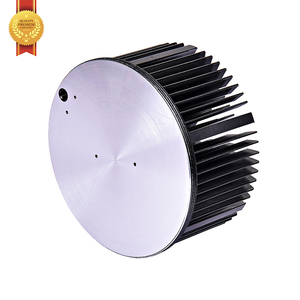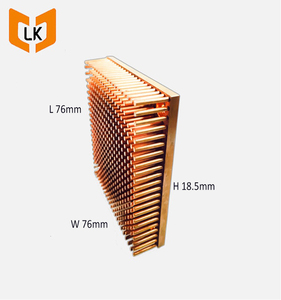(51935 products available)
































































































































































































































China heatsinks are designed to dissipate heat from electronic components, ensuring they operate at safe temperatures. Various types of heatsinks are manufactured in China, including the following:
Passive Heatsink
A passive heatsink relies on natural convection to dissipate heat. It has a simple design and consists of a base and several vertical fins. The passive heatsink is the most commonly used type. It is suitable for low-power applications and is cost-effective. The absence of moving parts makes it a reliable option.
Active Heatsink
The active heatsink dissipates heat more efficiently than the passive type. It has a fan or blower that produces a forced air stream over the fins. The active heatsink is suitable for high-performance applications. It requires power to operate the cooling fan.
Heatpipe Heatsink
This type of heatsink uses heat pipes to transfer heat from the source to a remote dissipation area. It can be designed as either active or passive. The Heatpipe heatsink is commonly used in laptops and high-performance CPUs. It is suitable for applications with space constraints. The heatsink provides efficient heat transfer over long distances.
Liquid-Cooled Heatsink
This heatsink is designed to work with liquid cooling systems. It circulates coolant through a pump to remove heat efficiently. The liquid-cooled heatsink is suitable for high-performance CPUs and GPUs. It has a high heat dissipation capacity and is ideal for overclocking. Additionally, it operates quietly.
Aluminum Heatsink
Aluminum heatsinks are made of aluminum extrusions. Aluminum is a light material that can be produced in different shapes. These heatsinks are suitable for low-cost applications. They have great thermal performance and are very versatile.
Copper Heatsink
Copper heatsinks are made of copper material. Copper has a higher thermal conductivity than aluminum. These heatsinks are designed for high-performance applications. They have a more substantial and more complex design.
Combined Metal Heatsink
This heatsink combines aluminum and copper to take advantage of both metals. It has a lightweight design and excellent thermal performance. The combined metal heatsink is suitable for various electronic devices.
Skived Heatsink
The skived heatsink is made from a single piece of metal. It has intricate fins that are formed by skiving (a subtractive manufacturing process). The skived heatsink has a high aspect ratio, which makes it more efficient. It is suitable for applications where weight is more important than cost.
China Heatsinks serve several important functions in electronics. They also have important features as discussed below.
Function
Heat Dissipation
Heatsinks dissipate heat from electronic components by spreading and releasing it into the air. They prevent overheating ensuring components operate optimally.
Increased Reliability
By preventing overheating, heatsinks extend the lifespan of electrical components. They promote higher reliability of the entire system.
Thermal Regulation
Heatsinks regulate the temperature of components maintaining it within safe limits. They ensure consistent performance over time.
Functions
Conduction
A heatsink for LED light fixtures transfers heat from the source to the fins using conduction. The heat then dissipates through convection and radiation.
Material
China heatsinks are usually made of metals with high thermal conductivity. Examples include aluminum and copper. Their light weight and cost-effectiveness make aluminum popular. On the other hand, copper has superior conductivity.
Geometry
Heatsinks have different shapes and sizes. Their design depends on the application and amount of heat to be dissipated. For instance, extruded or folded heatsinks have parallel fins spaced uniformly. They are suitable for forced or natural convection. Other geometries include circular, shaped, and compact heatsinks.
Surface Area
Heatsinks increase surface area through fins and spikes. The larger the surface area, the more heat dissipates into the air. This is critical in applications where space is limited.
Airflow
Some heatsinks have fans attached to them. The fans blow air over the heatsink and increase the cooling efficiency. However, the fans generate noise and require power. Therefore, they are not used in passive cooling systems.
Mounting Options
Heatsinks have different mounting methods. For example, thermal adhesive, screws, and clips. The choice of mounting options depends on the application, reliability requirements, and assembly costs.
Customization
China heatsinks can be customized to meet specific application needs. This involves varying the size, shape, and material of the heatsink. Some manufacturers add special coatings to improve thermal dissipation capabilities.
Material
Conductivity: Select a material with excellent thermal conductivity, like copper or aluminum. Copper dissipates heat better, but aluminum is lighter and rust-resistant. Consider the device's needs; stronger cooling needs need copper, and aluminum is enough for less heat.
Weight: If portability matters, aluminum's lightness is excellent. It keeps laptops and mobile devices portable.
Durability: Aluminum resists corrosion, prolonging the component's life and lowering maintenance. It is suitable for devices exposed to weather changes.
Size and Shape
Space: Measure the area where the heatsink will go. Ensure the right size fits without crowding parts. Check the specifications to determine the ideal heatsink size for the application.
Design: Think about how the heatsink is built. Slim models use little room. Tall ones with fins spread heat better. Pick a design that matches cooling performance goals and physical limits.
Cooling Method
Passive: Passive cooling uses natural airflow. It's calm and needs no energy. Use it for low-heat gadgets or where quiet matters.
Active: Active cooling has a fan that circulates air. It works well and is good for high-heat machines like gaming systems. It prevents overheating and maintains optimal performance.
Compatibility
Socket: Ensure the heatsink fits the CPU socket. Check manufacturer details for compatibility. Different sockets need different mounting methods.
Mounting: Look at how the heatsink attaches. Make sure it matches current setups. Solid mounting stops part failure.
Performance
Cooling Capacity: Check the heatsink's cooling power. Look at ratings like thermal resistance or junction-to-ambient thermal resistance. Pick one that meets or exceeds the chip's heat output.
Airflow: For fan-equipped heatsinks, check the fan's CFM (cubic feet per minute) rating. Higher CFM means more air circulation and better cooling.
Q1. What is a semiconductor China heatsink?
A1. A semiconductor China heatsink is a device used to dissipate heat from semiconductor components such as transistors, diodes, or integrated circuits. They are usually made of aluminum or copper and are designed to increase the surface area for heat dissipation by convection and conduction.
Q2. What are the three types of heatsinks?
A2. The three types of heatsinks are as follows: non-contact heatsink, active heatsink, and passive heatsink. A non-heat sink contact type is used when there is a need for a cost-effective solution. An active heatsink is used when there is a need for small form factors or high-performance applications. A passive heatsink is used when there is a need for reliability or simplicity.
Q3. What is the common problem of a China heatsink?
A3. Some common problems include: poor thermal performance due to inadequate heat dissipation, installation issues such as misalignment or improper mounting, and material quality concerns like corrosion or low thermal conductivity. Others are insufficient airflow, dust buildup, and fan noise.
Q4. How does one choose a heat sink?
A4. To choose a heat sink one must consider some important factors such as the thermal resistance, size and form factor, material and construction, airflow and fan compatibility, and the efficiency of the heat sink. One must also consider the price and reliability of the heat sink.
The keyword "china heatsink" shows a stable web search volume trend with an average monthly search count of 10, exhibiting no percentage change over the past three months and a year. Over the last twelve months, the web search volume data indicates a pattern of alternating between zero and ten web searches per month.
Analyzing the monthly search data for "china heatsink" reveals a distinctive fluctuation pattern. Search volumes peak at ten in January, February, May, June, July, September, October, and November, with notable absences in March, April, and August where web searches dropped to zero. This pattern suggests a cyclical interest in China heatsinks, possibly linked to specific industry needs or seasonal demand variations.
The consistent return to a web search volume of ten after dropping to zero each time indicates a sustained underlying interest in this product, likely driven by ongoing requirements in consumer electronics and related industries. Despite the stability in average monthly web searches, the alternating pattern of web search volumes points to potential seasonal influences or market events affecting the demand for China heatsinks.